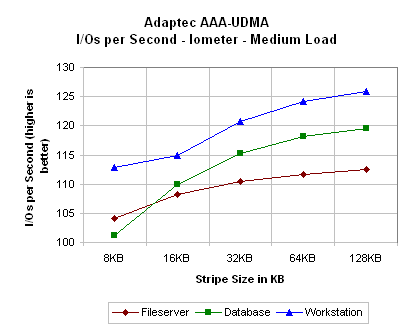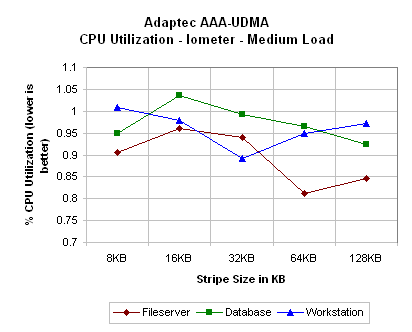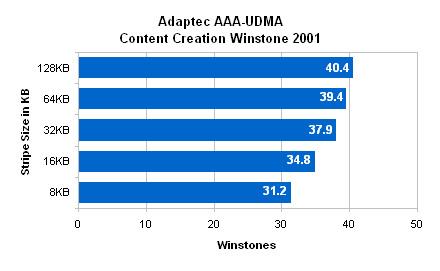Performance: Adaptec AAA-UDMA

The I/Os per second performance of our first hardware RAID card, the Adaptec AAA-UDMA, keeps improving as stripe size is increased. Much like we saw with the limited stripe sizes on the Iwill SIDE RAID100, the Adaptec AAA-UDMA hits a stripe limit before performance begins to decrease again.

Once again we see a positive linear trend with the number of MBs per second the array is able to process and the stripe size of the array. If more stripe sizes were present, we would almost certainly see performance peak as we saw with other cards. For the AAA-UDMA, the 128KB setting seems to be the best.

As one could predict by examining the other AAA-UDMA graphs, the I/O response time of the card keeps decreasing as stripe size is increased. Once again, performance keeps increasing throughout the stripe range because of the limited size that the stripes can be.

The CPU utilization of the Adaptec AAA-UDMA is rather spastic, with hardly any trends in the data. This can be attributed to the fact that the CPU is not actually performing the RAID calculations. It is for this reason that the CPU utilization numbers on this card are lower than those of the software RAID cards. We will discuss this more in a bit.

The performance gain that the AAA-UDMA is able to realize when increasing stripe size was quite impressive. From the slowest stripe size of 8KB to the fastest of 128KB, the performance of the card increased a full 29%.










2 Comments
View All Comments
kburrows - Thursday, December 4, 2003 - link
Have you run any tests on any onboard RAID solutions for RAID 0 & 1? I would love to see the results posted for the new SATA RAID on the Intel 875 boards.Anonymous User - Sunday, August 17, 2003 - link
In adressing the performance of an raid array with different stripe sizes, you miss an important factor, namely the accestime of an disk. This wait time has two main couses. First the head positioning and second the rotational latency (the heads track the right trace, but position where the read start has not passed under the head). You may have to wait from 0 to (in the worst case) a full cycle.Since the disks move independently You can calculate that the average latency to get an small file is minimal when the stripe size is about an full cycle of an disk in the array (aprox. 250kB today). All other factors I do know do not reduce this. (controller overhead, transport,...)
So I think that today a minimum stripe size of 256kB should be used.